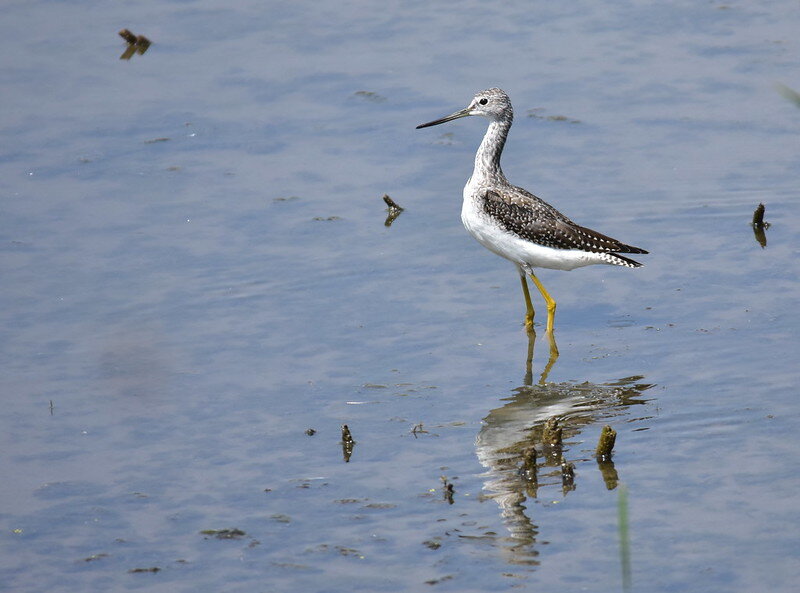Bird Stories from Your Neighbors
The Copper Valley is filled with keen observers of nature, many of whom have a particular fondness for birds. Even in the coldest, darkest parts of winter, some steadfast little creatures remain to bring us cheer. I spoke to several area residents about their bird observations, and I heard some stories I would love to share with you.
Red-breasted nuthatch. Photo by Greg Schechter.
Everyone I spoke to noticed fluctuations in predatory birds following fluctuations in prey species. This was particularly so with goshawks and owls. Similarly, the large cone crop this summer and fall seemed to bring a spike in birds who feed off of cones, particularly an enormous wave of crossbills. Although this is not a bird, I noticed that squirrels were not only abundant during this bumper cone crop, but that they built elaborate monuments of cone clusters all over my neighborhood.
Several area bird enthusiasts said that nuthatches had become more common in their areas in recent years. Nuthatches on Copper Valley properties have been staying into the winter, and more seem to be in breeding pairs in summer. Only Connie Gavvitt on the Nabesna Road took on a wild animal for the sake of a nuthatch, however. “We had one nuthatch every year. This year we had two and we were pretty excited about it. Then we had this lynx that caught one and ate it. I thought at first it was a vole and then I realized, ‘Oh no, it’s a nuthatch.’ I ran out the door to try to save it, but he leaped and bound and grabbed the nuthatch.”
McCarthy based naturalist Mark Vail shared a story of bird observations paying off. He had documented a Cape May warbler singing in his garden with the help of neighbor Danny Rosenkrans. The sighting was posted on a rare bird sightings of Alaska webpage. “Within an hour,” Vail recalled, “A guy asks, ‘If I leave Anchorage today can I see it tonight?’ The guy showed up at 11:30 at night with a case of beer and by 5:30 in the morning he was gone, reporting it’s not just the bird but a mate too. I entertained over 20 birders, some of whom drove 900 miles to go see this bird.” When one birder asked what he needed from town, Mark replied he could use some cheese. “She brings me two bricks of cheese, a hoagie and a bag of cherries”, he said. “I’m thinking, ‘I’m going to have to find some more rare birds.’”
Breeding male Cape May warbler. Photo by US Fish & Wildlife Headquarters.
In addition to beer and cheese, Vail benefitted from the natural history skills of the birders who came to see him. One skilled naturalist helped him find the warblers’ nest after he noticed a variation in birdsong right in the vicinity of a group of five trees. Vail did find the nest, which led to the documentation of the first breeding pair of Cape May warblers in Alaska.
Kenny Lake based conservationist Ruth McHenry had some sobering thoughts about her recent observations. She feels that the shorebird abundance and diversity she has seen in the past has gone way down, and wonders whether this is tied to the general decline in numbers of North American birds observed. “We used to go to a couple of local ponds particularly in the spring and the yellowlegs always used to scold us. [Recently] We just weren’t seeing them.”
McHenry also shared the power of sharing birds with young people in the area. Although the most recent event was cancelled due to coronavirus, Copper Country Alliance volunteers typically bring young people and their families to a local lake with optical equipment mounted on tripods every spring. She recalled, “The kids are just so amazed!”
Greater yellowlegs. Photo by US Fish & Wildlife Service Mountain Prairie.
Danny Rosencrans, who spends his time both on the Richardson Highway corridor and in McCarthy, finds it to be a special treat when blackpoll warblers come to visit. They are not as regular as many of the other birds that come to his property. He also had breeding great horned owls nearby this summer, which he confirmed when he looked on his clothesline to see two adults and a juvenile sitting there passing the time.
Rosenkrans also shared a sad story, which I am passing on to illustrate the importance of cleaning up sport fishing gear that gets tangled and left along our waterways. Last spring, when he was walking along the Tonsina river, he found a bald eagle that had died. It was hanging upside down from a tree. The eagle had a fishing hook in its beak. The line must have gotten tangled in the tree’s branches, flipping the bird over when it tried to take off. The eagle did not have the leverage to take flight from that position.
My own favorite observation in recent memory was in late October on the Tiekel River near my home at 46 mile on the Richardson Highway. On a frigid morning, outside of its normal range, I found tracks in the snow from a great blue heron.
Great blue heron tracks on the Tiekel River. Photo by Allison Sayer.
Article by Allison Sayer
Please keep your wildlife stories coming. We’d love to hear more!




